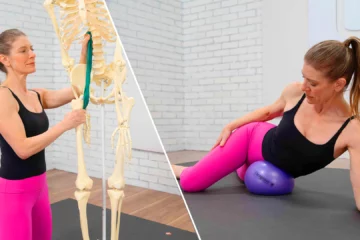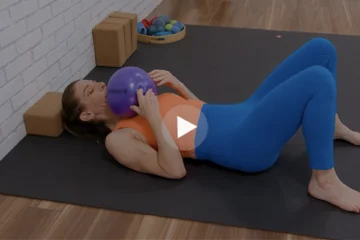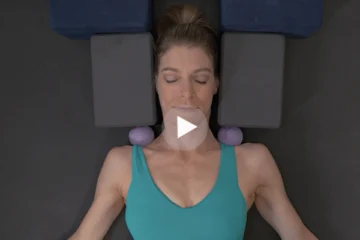
Here at Tune Up Fitness, we are firm believers in ‘Prehab’: healthy biomechanics and myofascial massage techniques that keep your tissues integrated and performing properly. We’ve blogged about how YTU can help with all kinds of sports, from golf and tennis to the endurance sports of Triathlons. Jill even created the Post-Athletic Stretch DVD for all kinds of athletes looking for freedom from pain. So whenever we find a fellow ‘body nerd’ – someone who’s as fascinated with the awe-inspiring mechanics of the human body as we are – we like to give a shout out!
Dr. Erik Dalton is a nationally recognized educator teaching effective techniques for the relief of pain through Myoskeletal Alignment and Myofascial Tissue Manipulation. Dr. Dalton’s Myoskeletal approach is definitely in line with ours, and we’d like to show you one of his videos that we found inspiring. (www.greenbot.com) Dr. Dalton demonstrates a technique to release the quadratus lumborum, which when excessively contracted can interfere with proper motion while walking (and watch especially for the graphic of the skeleton climbing the stairs as each muscle lights up when it is fired – it’s beautiful!). This particular video has a focus on golf and lower back pain.
Golf, much like yoga, retains an attraction into middle age and beyond, and understandably so. It asks both physical fitness of its players (but without the high impact of faster sports that become less accessible as we age) and the mental stamina to play a game that can last hours on end.
Unfortunately, it does come with one big problem: the golf swing is a biomechanical disaster (the author John Updike compared it to “a suitcase into which we are trying to pack too many things.”). Repeated spinal rotation and extension in the same direction, shot after shot and day after day, sets up enormous muscular imbalances in the lower back, shoulders and hips.
In addition, unless the player spent sufficient time warming up the muscles of the torso, there is not much other movement in golf to prepare the lower back for such deep and fast rotation. It’s no wonder that more than 50% of male golfers and 45% of female golfers suffer from lower back pain. The quadratus lumborum (or QL) is one of the ‘usual suspects’ for lower back pain caused by the golf swing (for a more detailed description of this muscle, see Jeff Lang’s blog on the lower back).
The YTU approach to releasing the QL is a perennial favorite pose of ours: the Sidewinder. The Sidewinder alternately contracts and stretches each side of the body, activating and releasing the QL, flushing the spinal cord with cerebrospinal fluid, and safely increasing mobility in the vertebrae.
While there are tons of expensive (and often invasive) treatments out there for relieving lower back pain, we believe that much of it can be prevented or remedied through proper stretch, strengthening and massage. Our goal here at YTU (and Dr. Dalton’s too it seems) is to provide you with the best movement and massage techniques to keep your lower back, as well as the rest of your body, healthy, happy and out of pain!












As a therapist who works with many golfers, I can definitely relate to the importance of protecting the lower back. The tips in this blog are incredible and I’ll be recommending these techniques to my clients.
This was so helpful! I have so many students (and my husband and sons) who suffer from back pain from their golf game and then the golf game suffers and they get further frustrated! Thanks for these great tools to help them more! This is also great for other one sided sports afficionados like tennis, pickleball, baseball and more! Thanks!
Many of the patients I see play golf and complain of low back pain and tightness. Having an effective technique for stretching and strengthening the QL, like the Sidewinder, is going to help them immensely. Great info!
My husband is a golfer and I will be able to accompany him in his practice! Great!
Stretching, strengthening, and massage… the myofascial golden trio! I love that you recommended Sidewinders as the go to release instead of just a static stretch. Both the benefits of strength and dynamic stretch, as you mentioned, with one exercise.
I love the game of golf! Golf like yoga teaches you to be present in the moment. You must have awareness of what your body is doing to perform a great swing. My husband has golfed for years and when he added yoga to his routine, he actually played some of the best golf, winning his league championship that year. More people should balance their golf game with yoga poses and techniques to warm up or relieve tightness after the round.
I love this idea of laterally extending and flexing the spin dynamically and passively. It makes it very accessible. I have a client who is an overweight golfer, this supine exercise seems like it would work well for him rather than standing lateral movement for any length of time.
As a golfer, I cannot agree more. When I started playing golf, I practiced my swing, hitting balls over 100 times almost on a daily basis at a local driving range. Many months later, I started to feel a pain on my lateral side of lower back. Everyone wanted to fix me by changing my swing and technique but no one advised me on my muscles, strength training, or proper warmup stretching. We often times pay too much attention on the movement or mechanics itself, but ignore what it takes in order for our body to make that movement.
I was researching rotation of the spine and thorax (not for gulfing…just for yoga classes and understanding the biomechanics more) and ran across your article. Both your article and the comments were helpful…now I am thinking about all the people over 50 locally who are playing golf (some just for the weekend) and see how a few yoga class options that really get into the QL will help.
Thanks Sarah. I enjoy reading your blog posts. I was attracted to this blog because like you say, I have many middle aged students in my yoga classes that are asking for poses and movements that can help with stiffness from playing golf. I love any reason to bring sidewinder into class!
This is Great Thanks Sarah!
I also like reading the comments from others….I have a lot of clients that play golf, this is eye opening. they’ll love doing the sidewinder I’m sure. 🙂
This post compliments my blind spot discovery of the day: ease of spinal rotation. I can now better see swide-winder’s purpose, especially in the context of crossfit in which our supposedly so varied movement paradigm has no programming of rotation, let alone prepping it for ease of rom elsewhere.
I’ve been a golfer since I was old enough to pick up a club. As a woman my swing has always surprised my male counterparts because of my range of motion. I’m very open in my back, shoulders, and arms. After beginning a yoga practice and becoming more flexible and mobile, my swing has certainly improved. My small stature inhibits the power behind my swing but the mechanics and leverage of my swing due to my flexibility puts that power back behind the ball. I agree that any sport (baseball, golf) where you swing one-side (left handed or right handed) is going to take a toll on the back. However, balancing such athletics with a consistent yoga practice will not only alleviate pain but also support a stronger athletic performance. Thanks for your post!
Nice video illustrating the location in which to access the QL from a side angle – But even more pleasing is that YTU offers a variety of techniques in which to massage the QL muscle with ball therapy and then add to that the many awesome YTU exercises that exist to tonify the low back and obliques..Sidewinder is a “must do” exercise on my daily list!!!
OMG! Can someone do that to me please??! I want someone to just take my hip and pull it away,that looks sooo good. My husband plays golf and he doesn’t listen to me when I tell him that with his extremely tight hamstrings and a posterior tilted pelvis in addition to improper technique and a lot of competitiveness to hit it hard and far…it’s a combination for disaster..hopefully this video will help him understand! Very insightful, thank you!
[…] hamstring stretching, hamstrings, Lower Back Pain, stretching, tight hamstrings The game of golf can be like a meditative experience. After all, silence or at least whispered voices are encouraged […]
I have clients who golf and side stretches are simply the best. Balances out their obliques and QL…or at least begins to introduce balance. For the hips, we use the yoga tune up leg stretch series. Works wonders.
My dad is an avid golfer and frequently has shoulder as well as lower back issues. He has been playing golf since he was old enough to hold a club. As he has aged, the rotation, flexion and extension of his spine has become more restricted, which greatly effects his ability to hit the ball. He is continually adjusting his swing to compensate. This would be a great exercise for his to warm up his back prior to heading to the golf course and help to maintain some flexibility in the spine.
The sidewinder is a fabulous warm-up to first of all be able to swing a golf club properly and although the stats say that it’s about half of the golfers that feel pain in their lower back does not mean that their QL doesn’t need some work. A locked up QL can translate pain or discomfort up to the hips, into the groin, the glutes or show up as sciatica-like pains and without the fluid motion in the lower back, knees and pectoral muscles can bear the brunt of the stress caused by a lack of mobility in the QL. Here I come sidewinder!
very interesting! i will definitely share this info with my husband – a golfer – and his golf buddies. i like the way the sidewinder isolates the obliques so those who cannot extend or flex their backs as easily can still work the oblique muscles and release tension in the QL. additionally, the QL stretches look effective for women who hike their hips all day carrying young children. (i’ll have to remember NOT to carry my child (when i have one) on my hips.. or at least alternate each side..)
OH Side-winder! yes– wow, my QL was sore after yesterday’s Day Two of YTU TT… I am happy to share this video and Jill’s dynamic warm-up to my golfing client(s). In Thai Massage, I have a technique that retracts the hip (in side position) and I am able to use my hand to reach the QL (think Trikonasna on the knee, as I drive my fingers into the QL! wow)…it is much more static but in this video, I appreciate the patient’s engagement of the QL…can I get a PNF? What what?! Makes me realize I can probably go a little deeper and release more fascia by encouraging my patients to engage, tense/find the end point… and then soften as my fingers penetrate into the side-body. Thanks!
So many sport activities (tennis, golf, baseball) use one side of the body repeatedly without balancing the other side and this repetitive action causes a lack of integrity in the connective tissue which translates to the skeletal system and compromises balance and alignment in the entire body. It is really important to stretch, extending and flexing, rotating,etc., both sides of the body to balance the overuse of these one sided sports.
Thank you Dr. Dalton! It’s always a pleasure to highlight inspirational figures in our field.
Thx for the kind post Sarah…fellow ‘body-nerd’. Nice You Tube video…good insight on the golf swing.